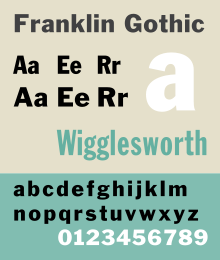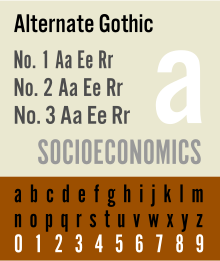

 | |
| Category | Sans-serif |
|---|---|
| Classification | Grotesque |
| Designer(s) | Morris Fuller Benton |
| Foundry | American Type Founders |
| Date released | 1902–1967 |
| Also known as | Gothic #1, Square Gothic Heavy, Gothic #16 |
Franklin Gothic and its related faces are a large family of sans-serif typefaces in the industrial or grotesque style developed in the early years of the 20th century by the type foundry American Type Founders (ATF) and credited to its head designer Morris Fuller Benton.[1] "Gothic" was a contemporary term (now little-used except to describe period designs) meaning sans-serif.
Franklin Gothic has been used in many advertisements and headlines in newspapers. The typeface continues to maintain a high profile, appearing in a variety of media from books to billboards. Despite a period of eclipse in the 1930s, after the introduction of European faces like Kabel and Futura, they were re-discovered by American designers in the 1940s and have remained popular ever since. Benton's Franklin Gothic family is a set of solid designs, particularly suitable for display and trade use such as headlines rather than for extended text. Many versions and adaptations have been made since.
Probably the best-known extension of Franklin Gothic is Victor Caruso's 1970s ITC Franklin Gothic, which expands the series to include book weights similar to Benton's News Gothic in a high x-height 1970s style. It is in part bundled with Microsoft Windows.[2][3]

Franklin Gothic itself is an extra-bold sans-serif type. It draws upon earlier, nineteenth century models from many of the twenty-three foundries consolidated into American Type Founders in 1892. Historian Alexander Lawson speculated that Franklin Gothic was influenced by Berthold’s Akzidenz-Grotesk types but offered no evidence to support this theory[4] which was later presented as fact by Philip Meggs and Rob Carter.[5] It was named in honor of Benjamin Franklin, who was also a prolific printer. The faces were issued over a period of ten years, all of which were designed by Benton and issued by A.T.F.[6]
Many years later, the foundry again expanded the line, adding two more variants:
It can be distinguished from other sans serif typefaces by its more traditional double-storey a and especially g (double-storey gs, common in serif fonts, are rare in sans-serif fonts following German models, but were quite common in American and British designs of the period), the tail of the Q and the ear of the g. The tail of the Q curls down from the center of the letterform.
Barnhart Brothers & Spindler copied the face as Gothic #1, while both Linotype and Intertype, called their copies Gothic #16. Monotype’s copy kept the name Franklin Gothic, but because of the demands of mechanical composition, their version was modified to fit a standard arrangement. The Ludlow version was known as Square Gothic Heavy.[7]
Due to the post-war popularity of Gothic faces, most producers of cold type offered their own versions of Franklin Gothic. These included:[8]
Digital copies have been made by Adobe, International Typeface Corporation, Monotype Imaging, and URW. Victor Caruso drew a multi-weight family for the International Typeface Corporation (ITC) in 1979 and in 1991, ITC commissioned the Font Bureau in Boston to create condensed, compressed and extra compressed versions of ITC Franklin Gothic. Bitstream’s version is called Gothic 744. Microsoft Windows has distributed "Franklin Gothic Medium," one of ITC's variants of the font, in all copies since at least Windows 95.
While ITC Franklin Gothic is the most common release, it has been criticised for modifying the structure of the family considerably. Calligrapher and design historian Paul Shaw argued that it was a failure for "mucking about with the distinctive Franklin Gothic g. In ITC Franklin Gothic...the ear on the g keeps popping up like a schoolchild overly eager to answer a question."[9]
The American Type Founders Collection (ATF Collection; unrelated to the original American Type Founders) has released a version named ATF Franklin Gothic. [10] The characters of this version are more expanded than many previous releases.
An open source interpretation of Franklin Gothic has been made by Impallari Type as Libre Franklin. Libre Franklin is available on Google Fonts.
 | |
| Category | Sans-serif |
|---|---|
| Classification | Grotesque |
| Designer(s) | Morris Fuller Benton |
| Foundry | American Type Founders |
| Date released | 1903 |
| Re-issuing foundries | Monotype |
| Design based on | Franklin Gothic |
| Also known as | Gothic Condensed (Linotype + Intertype + Ludlow) |
Alternate Gothic was designed by Morris Fuller Benton for A.T.F. in 1903. It is essentially a moderately bold condensed version of Franklin Gothic, made in three numbered widths. No.1 is the most condensed, 3 the least.
This face was copied by Monotype under the same name, #1 by Ludlow, Linotype and IntertypeasGothic Condensed. Ludlow’s Trade Gothic Condensed is very similar as well. Two variants were made:
Alternate Gothic was copied by CompugraphicasAlpin Gothic.[12]
Digital copies have been made by URW, Elsner+Flake, and MonotypeasCG Alternate Gothic #3.
Micah Rich and several contributors of The League of Moveable Type have made a popular OFL-licensed version of Alternate Gothic #1, League Gothic.[13]
League Gothic is a condensed sans-serif typeface released by The League of Moveable Type. The design of League Gothic was based on Alternate Gothic, a typeface originally designed by Morris Fuller Benton in 1903. Both No. 1 and No. 2 are available, each in a single semi-bold weight.[13]
League Gothic was also used as the basis for Warsaw Gothic, an expanded font family with some altered glyphs produced in 2015 by Robert Jablonski.[14]
Oswald, by Vernon Adams, is a screen-optimized adaptation of Alternate Gothic No. 2, with six weights and no italics.
 | |
| Category | Sans-serif |
|---|---|
| Foundry | Impallari Type |
| License | SIL Open Font License |
| Design based on | Franklin Gothic |
| Website | https://fonts.google.com/specimen/Libre+Franklin |
Libre Franklin is an open source spinoff of Franklin Gothic made by the Argentine type foundry, Impallari Type. It has nine weights with italics.[15]
 | |
| Category | Sans Serif |
|---|---|
| Foundry | United States Web Design System |
| License | SIL Open Font License |
| Design based on | Libre Franklin |
| Website | https://fonts.google.com/specimen/Public+Sans |
Public Sans is based on Libre Franklin with numerous modifications by the United States Web Design System (General Services Administration). It has nine weights with matching italics and a variable weight axis.[16]
Public Sans is the official font of the government of New South Wales, Australia's most populous state.[17]
Raph Levien began work on an adaptation of the heavy variant of Franklin Gothic found in a 1941 specimen, copying its irregularities. Levien's adaptation was never finished with only the lowercase completed. Levien had stated at the time of abandonment that he planned on switching to a cleaner 1912 specimen if and when the project is completed.[18]
Oswald, League Gothic, Warsaw Gothic, Libre Franklin, and Public Sans are all licensed under the SIL Open Font License.
| Category | Sans-serif |
|---|---|
| Classification | Grotesque |
| Designer(s) | Morris Fuller Benton |
| Foundry | American Type Founders |
| Date released | 1907 |
| Design based on | Franklin Gothic |
Monotone Gothic was designed by M.F. Benton for A.T.F. in 1907. It is essentially a lighter, more extended version of Franklin Gothic. Only one weight was made and it was apparently never copied under that name by any other foundry. Digital versions of Franklin Gothic Light Extended are essentially knock-offs of this face.[19]
 | |
| Category | Sans-serif |
|---|---|
| Classification | Grotesque |
| Designer(s) | Morris Fuller Benton |
| Foundry | American Type Founders |
| Date released | 1908 |
| Design based on | Franklin Gothic |
| Also known as | Trade Gothic (Linotype), Record Gothic (Ludlow), Balto Gothic, (Baltimore Type & Composition Company) |
News Gothic was designed by M.F. Benton for A.T.F. in 1908 as a continuing effort to consolidate and systematize the 19th-century Gothic faces inherited from the company’s predecessors. It is essentially a medium weight companion to Franklin Gothic.
As with Franklin Gothic, the foundry expanded the line sometime later, adding two more variants:
Particularly extensive designs in the same style were Trade Gothic from Linotype and Record Gothic by Ludlow.[20] [21] Benton Sans is a notable, and extremely comprehensive, modern revival.[22][23]
| Category | Sans-serif |
|---|---|
| Classification | Grotesque |
| Designer(s) | Morris Fuller Benton |
| Foundry | American Type Founders |
| Date released | 1908 |
Lightline Gothic was designed by M.F. Benton for A.T.F. in 1908 as a lighter version of News Gothic, which makes it an ultra-light version of Franklin Gothic. Only one weight was made and it was apparently never copied under that name by any other foundry. Digital versions of Franklin Gothic Ultra-Light are essentially knock-offs of this face.
In 1921, M.F. Benton had the capitals of this face cast in different sizes on identical bodies, thus creating, ex nihilo,alining Gothic which was sold under the name Lightline Title Gothic[24]
This section needs additional citations for verification. Please help improve this articlebyadding citations to reliable sources in this section. Unsourced material may be challenged and removed. (June 2009) (Learn how and when to remove this message)
|